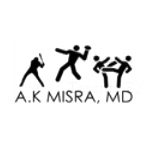Health Tips brought to you by U.S. HealthWorks Medical Group. Our experienced medical experts provide information here that we hope will broaden your healthcare knowledge.
We recently discussed how sprains are the most common injury among top workplace injuries. Here we go into greater depth on how to treat sprains with Dr. Anuruddh Misra, medical director for U.S. HealthWorks in South San Francisco. Dr. Misra is also double Board Certified in Sports Medicine and Internal Medicine.
Q: U.S. HealthWorks recently talked about how sprains are the most common workplace injury. Why are people so susceptible to sprains?
A: Sprains rank as one of the most common injuries incurred secondary to work, play or no specific action of intent. Good education is useful in helping to prevent sprains, however the incidence and prevalence of sprains are more a function of accidents such as a misstep, a fall or lack of protective equipment, which is why we hear about and see them so often. Certain sprains are more common than others (i.e. ankle sprains are more common than knee sprains). For example, in soccer players there is no injury more common than an ankle sprain but this injury is even more common in football and much more so in basketball:
Q: How do I know if I’ve sprained something?
A: Often the first sign is significant pain and swelling associated with an acute sprain. Concurrent functional impairment is often seen, too. Any time there is any concern or thought of a sprain, it is crucially important to be evaluated by a professional who is adept at analyzing if more work-up is warranted (such as an x-ray and/or CT scan or MRI). Certain criteria known as the Ottawa Ankle Rules is available for ankle injuries to help sort out which patients require additional imaging
Q: Can I help my injury heal with at-home remedies?
A: Yes. I went into detail about this topic in one of my past blog posts, and perhaps the most useful portion of that blog to answer this question is to do these on your own until you get evaluated:
I use the acronym “PRICE” to explain and teach the essential elements of minor strain and sprain management:
P – Pain control
R – Rest
I – Ice
C – Compression
E – Elevation
This is a medically reasonable way to get started in advance of attaining a formal medical evaluation.
Often healing can be moved along more rapidly by referral to a physical therapist to achieve mechanotransduction or “motion is lotion,” which can be reviewed on another blog post of mine.
Q: When is it time to see a doctor for a sprain?
A: I believe anytime there is a concern as it relates to sprains, the sooner one is evaluated the better. The primary reason is that such injuries may not be as simple or straightforward as they may seem. Should something more concerning be present (such as a fracture, dislocation or joint instability), it must be diagnosed and addressed immediately.
For example, the Danis-Weber classification of ankle fractures reminds us why an injury thought to be a “simple ankle sprain” should not be taken lightly:
Q: Besides common sprains like ankles, what other body parts can someone sprain?
A: Virtually any joint can be sprained such as fingers and toes, shoulders and elbows, and wrists and knees. I would make a point of distinction as it relates to an injury this is often confused with called a strain. I have seen the terms used interchangeably, and it is incorrect to do so. By the purest of definitions, sprains are ligament-oriented injuries while strains are muscle-oriented injuries. Sprains typically take longer to heal because the blood supply to ligaments is not as robust as it is to muscles. This, again, is why a physical therapist is often pivotal to a more rapid recovery from these often challenging injuries (sprains).
Lastly, to date the only evidence in the literature as it relates to bracing and preventing sprains is focused on the ankles. It has been demonstrated that wearing protective durable medical equipment for ankles (i.e. ankle braces) is the only prophylactic brace that reduces the risk of incurring such an injury, especially if an ankle sprain has already been incurred at least once prior (i.e. secondary prevention).








